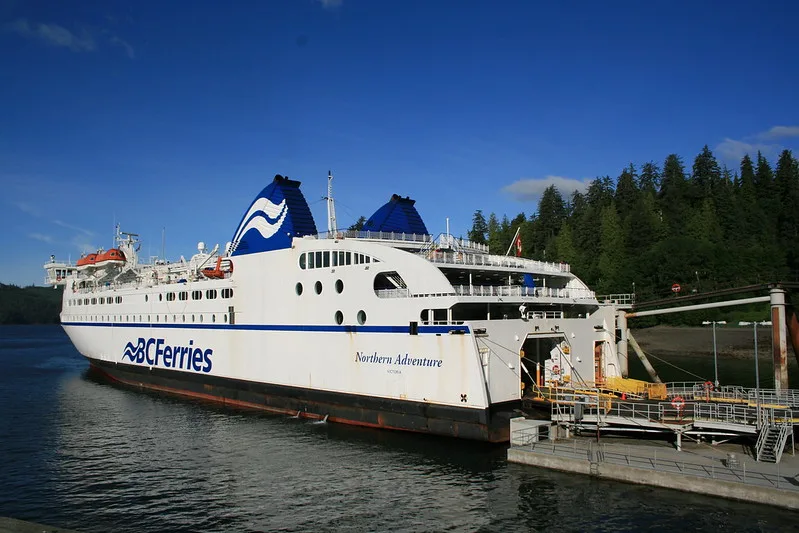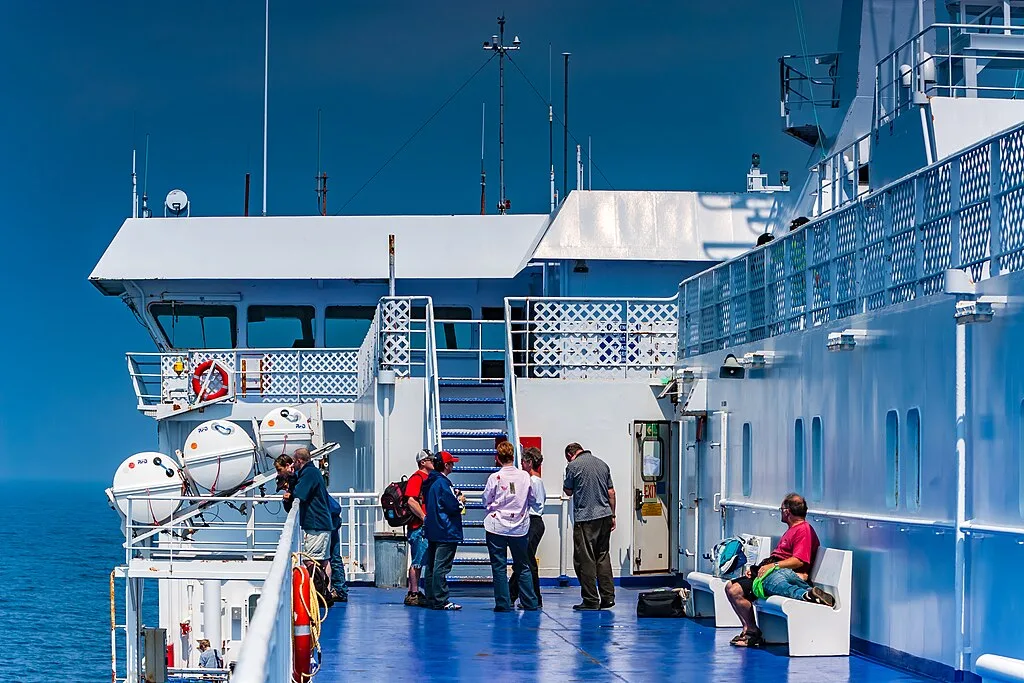Imagine gliding across sparkling waters, surrounded by breathtaking coastal views and pristine landscapes. Canada’s ferries and coastal services offer more than just a means of transport—they are gateways to adventure, culture, and community.
From the ancient canoes of Indigenous peoples to the cutting-edge vessels of today, Canada’s rich history of water transport is a fascinating journey through time. Discover how these services have evolved to become essential lifelines for both residents and tourists.
Learn about the major players like BC Ferries and Marine Atlantic, and how their extensive networks and top-notch services make travel not only convenient but also an unforgettable experience. Whether you’re a local commuter or an eager explorer, these operators cater to every need.

Аuthor: B.C. Ministry of Transportation and Infrastructure – www.flickr.com
History of Ferries and Coastal Services in Canada
Early Beginnings and Historical Significance
Long before European settlers arrived, Indigenous peoples in Canada used canoes and other boats to travel across lakes, rivers, and along the coast. These early boats were essential for hunting, fishing, and trading between communities. When Europeans came in the 15th and 16th centuries, they quickly saw the importance of waterways for travel and trade. Because of Canada’s vast and rugged landscape, traveling by water was often easier than overland. Ferries soon started to offer regular, reliable transport across these waterways.
Steam-Powered Revolution
In the early 19th century, the introduction of steam-powered boats changed everything. These steamships could carry more passengers and cargo than sailboats or rowboats, making them perfect for regular ferry routes. Steam ferries became common on major rivers and coastal areas, helping people and goods move more efficiently. By the late 19th and early 20th centuries, ferries had become a vital part of Canada’s transportation system. They connected remote communities, supported trade, and allowed people to travel more easily.
Growth and Modernization
As Canada grew, so did its ferry services. In the mid-20th century, diesel-powered ferries and larger vessels were introduced. These ferries could carry vehicles, which was important as more people owned cars. Governments and private companies invested in new terminals, better safety standards, and expanding route networks. Ferries also became a key part of tourism, offering scenic routes and comfortable travel experiences. The mid-20th century was a time of significant growth and modernization for Canada’s ferry services.
Key Milestones
Several key events have shaped the development of ferry services in Canada. In the early 1800s, the Royal Mail Line began regular mail and passenger services along the east coast. In 1817, the first steam-powered ferry, the Frontenac, started operating on Lake Ontario. A major milestone was the creation of BC Ferries in 1960. Faced with growing demand for reliable transport between the mainland and Vancouver Island, British Columbia’s government set up BC Ferries, which has become one of the world’s largest ferry operators.
In 1977, Marine Atlantic was established to manage ferry services between Newfoundland and Labrador and the mainland. This was crucial for the region, ensuring year-round connectivity and supporting economic growth. Marine Atlantic has modernized its fleet and infrastructure, maintaining its vital role in linking these provinces. More recently, BC Ferries adopted LNG (liquefied natural gas) technology in the 2010s to reduce environmental impact. Innovations like online booking and real-time tracking have also improved the customer experience.
Major Operators of Water Transport in Canada
BC Ferries
BC Ferries is one of the largest operators of water transport in the world. It was established in 1960 by the government of British Columbia to provide reliable transportation between the mainland and Vancouver Island. Over the years, BC Ferries has grown significantly, becoming a vital part of the province’s transportation network. Today, the company operates 35 vessels and serves millions of passengers and vehicles each year.
Routes and Services
BC Ferries operates 25 routes, connecting numerous coastal communities in British Columbia. The primary route is between Tsawwassen (near Vancouver) and Swartz Bay (near Victoria on Vancouver Island). This is one of the busiest and most important routes for both passengers and freight. Other significant routes include Horseshoe Bay to Nanaimo and Tsawwassen to Duke Point. BC Ferries also serves the Gulf Islands, Northern BC routes, and the Sunshine Coast.
BC Ferries provides a range of services to meet passengers’ needs, including lounges, dining options, and onboard shops. For those traveling with vehicles, there are services for cars, trucks, and RVs. The company also offers reservations for popular routes, ensuring a smooth travel experience during busy periods. BC Ferries plays a significant role in supporting tourism by offering scenic routes and travel packages.
Marine Atlantic
Marine Atlantic is another major operator of water transport in Canada. It was created in 1977 to manage services between Newfoundland and Labrador and the mainland. Marine Atlantic is crucial for maintaining the connection between Newfoundland and Labrador, providing year-round service to ensure the movement of goods and people. The company operates a fleet of modern vessels designed for both passenger comfort and freight capacity.

Author : Michel Rathwell – wikimedia.org
Routes and Services
Marine Atlantic operates two primary routes: North Sydney (Nova Scotia) to Port aux Basques (Newfoundland) and North Sydney to Argentia (Newfoundland). The Port aux Basques route operates year-round and is the primary connection, while the Argentia route runs seasonally during the summer. These routes are essential for transporting goods and for residents and tourists traveling to and from Newfoundland.
Marine Atlantic offers various services to enhance the travel experience. Passengers can enjoy comfortable seating areas, dining options, and entertainment on board. Cabins are available for longer trips, providing a restful environment during overnight journeys. For freight transport, Marine Atlantic offers reliable services to ensure goods reach their destinations safely and on time. The company is committed to high safety and customer service standards.
Other Notable Operators
- Société des Traversiers du Québec (STQ): STQ is a key operator in Quebec, managing several routes across the St. Lawrence River. These services are crucial for connecting communities and supporting economic activity in the region. Notable routes include Quebec City to Lévis and Tadoussac to Baie-Sainte-Catherine, which are important for daily commuters, tourists, and the transport of goods.
- Wood Islands Ferry: The Wood Islands Ferry connects Prince Edward Island with Nova Scotia. This service is significant for both locals and tourists, offering a scenic and convenient route between the two provinces. It operates seasonally, with multiple crossings per day during peak season.
- British Columbia Inland Ferries: The British Columbia Ministry of Transportation operates several inland routes. These vessels are vital for connecting remote communities and providing access to otherwise hard-to-reach areas. Examples include the Kootenay Lake service and the Arrow Lakes service. These services are often free and play a crucial role in the daily lives of residents.
Private Operators
Private companies also contribute to Canada’s network. For instance, Bay Ferries Limited offers services between New Brunswick, Nova Scotia, and Maine (USA). Bay Ferries operates the Fundy Rose, which connects Saint John, New Brunswick, to Digby, Nova Scotia. This route is important for tourism and regional connectivity, offering a scenic journey across the Bay of Fundy.
Conclusion
Canada’s rich history of water transport dates back to Indigenous canoes and evolved with steam-powered and diesel-powered vessels. BC Ferries and Marine Atlantic are major operators, providing extensive networks and high-quality services for both passengers and freight. BC Ferries operates 25 routes in British Columbia, while Marine Atlantic connects Newfoundland and Labrador with the mainland. Other notable operators include STQ in Quebec, Wood Islands Ferry, and various inland routes managed by British Columbia’s Ministry of Transportation. Private companies like Bay Ferries Limited also play a crucial role in connecting regions and supporting tourism and economic activities.
FAQs
What are the main ferry routes in British Columbia?
The primary routes include Tsawwassen to Swartz Bay, Horseshoe Bay to Nanaimo, and Tsawwassen to Duke Point.
How do Marine Atlantic’s services connect Newfoundland and Labrador to the mainland?
Marine Atlantic operates two main routes: North Sydney (Nova Scotia) to Port aux Basques (Newfoundland) and North Sydney to Argentia (Newfoundland).
What are some notable routes operated by the Société des Traversiers du Québec (STQ)?
Notable routes include Quebec City to Lévis and Tadoussac to Baie-Sainte-Catherine.
How does the Wood Islands Ferry contribute to regional connectivity?
The Wood Islands Ferry connects Prince Edward Island with Nova Scotia, offering a scenic and convenient route, especially during peak season.
What role do private companies play in Canada’s water transport network?
Private companies like Bay Ferries Limited operate routes such as the Fundy Rose, connecting Saint John, New Brunswick, to Digby, Nova Scotia, and supporting tourism and regional connectivity.